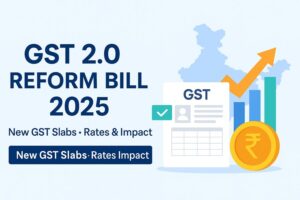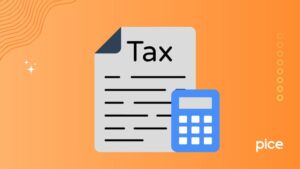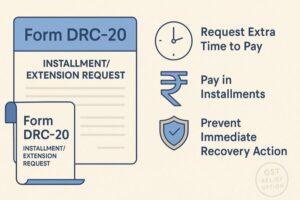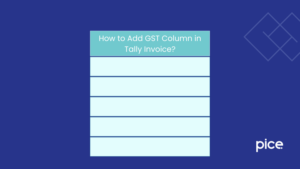How to convert composition to regular in GST?
- 13 Aug 24
- 16 mins

How to convert composition to regular in GST?
- What is the composition of the GST scheme?
- Advantages of Composition Scheme
- Disadvantages of Composition Scheme
- What is the regular GST or normal scheme?
- Business eligible to opt for composition scheme
- Difference Between Composition GST & Regular GST Schemes
- How to Switch from Composition GST to Regular GST
- Conclusion
Key Takeaways
- Strategic Decision: Choosing between the composition and regular GST schemes is a strategic decision, reflecting your business model and growth plans. Smaller, local businesses may prefer the simplicity of the composition, while larger enterprises may opt for the flexibility of the regular scheme.
- Eligibility Matters: Understanding the eligibility criteria for the composition scheme is essential to avoid compliance issues and ensure it aligns with your business needs.
- Balance Compliance and Flexibility: The Composition Scheme offers simpler compliance but limits operational flexibility, whereas the Regular allows for more complex operations but requires detailed compliance.
- Plan Before Switching: Transitioning between schemes, especially from composition to regular, requires careful planning to manage tax implications and compliance changes.
India's indirect economy structure has changed greatly through the implementation of GST. It integrates the payment of different taxes into one, thereby facilitating business administration and compliance. Amongst all the components that make up GST, the composition scheme and the regular scheme are two of the very important avenues that are meant for businesses.
Handle all your sales and purchase invoices in one place.
Pice’s all-in-one invoice management tool helps you track, send, and organize invoices from a single dashboard. Automatically share new invoices with customers, send timely payment reminders, and keep your collections under control—effortlessly.
Want early access? Fill out this form to get request a demo!
Knowing these schemes is necessary for small and medium-sized businesses (SMEs) to efficiently navigate the tax landscape.
What is the composition of the GST scheme?
The composition scheme under GST is designed for small and regular taxpayers to lessen their tax compliance burden. It allows eligible businesses to pay tax at a nominal rate based on their turnover. It gives a hand to GST procedures and makes compliance less burdensome, mainly for SMEs.
Advantages of Composition Scheme

The composition scheme enjoys some benefits, like reduced tax procedures, decreased compliance rules, and a smaller tax burden. This is enough to persuade a lot of small businesses to use tax accounting, and tax compliance problems will not be in their way.
- Simplified Compliance: The Composition Scheme significantly reduces the compliance burden on small businesses. Under this scheme, taxpayers are required to file returns quarterly, as opposed to monthly filings in the case of the regular. The reduction in paperwork and compliance costs could be achieved with simplification.
- Lower Tax Liability: One of the most attractive aspects of the Composition Scheme is the lower tax rate. Compared to the Regular Scheme, where tax rates can be higher and vary across different goods and services, the Composition offers a nominal tax rate. These may result in really big savings for small companies.
- Reduced Compliance Costs: With simplified record-keeping and fewer compliance requirements, businesses can save on costs related to tax consulting and accounting services. This is especially crucial for microenterprises, which are known to have minimal resources to operate on.
- Ease of Doing Business: The straightforwardness of the Composition Scheme allows business owners to focus more on their operations rather than being bogged down by the intricacies of tax filings. This can contribute to better management and business growth.
- Limited Interaction with Tax Authorities: Due to the simplified nature of tax filings under the Composition Scheme, there's typically less scrutiny and fewer interactions with tax authorities. That is a relief for small business owners, many of whom became alarmed at tax compliance.
- Cash Flow Benefits: By paying a fixed percentage of their turnover as tax, businesses can have a clearer understanding of their tax liabilities, helping in better cash flow management. Unlike the regular, where the tax liability may vary significantly based on the credit of the input tax and other factors, the composition offers more predictability.
- Attractiveness to Small Businesses: The composition is specifically designed for small businesses, which makes it inherently suited to their needs. By reducing the tax burden and compliance requirements, the scheme makes it easier for small enterprises to thrive in a competitive market.
Disadvantages of Composition Scheme
However, the scheme has its limitations. Businesses under this scheme cannot claim input tax credit (ITC), and their tax base becomes limited as they can only cater to local customers. These restrictions can impact the scalability and profitability of businesses.
- Ineligibility for Input Tax Credit (ITC): Businesses opting for the Composition cannot claim Input Tax Credit on their purchases. This limitation can lead to higher overall costs, as the tax paid on inputs becomes a cost to the business.
- Restriction on Interstate Sales: Businesses under the Composition GST are not allowed to undertake interstate sales. This restriction can significantly limit the market reach and growth potential of a business, confining its operations to within the state it is registered in.
- No E-commerce Transactions: Composition dealers are prohibited from selling goods through e-commerce platforms. This is a significant disadvantage in today's digital age, where e-commerce sales can contribute substantially to a business's revenue.
- Limited Customer Base: Since Composition GST taxpayers cannot issue tax invoices, registered buyers who could have claimed the tax credit on their purchases are less likely to engage with them. This limitation can affect business relationships with certain segments of customers.
- Turnover Limit: The benefit of the Composition is available only to businesses with a turnover below a specified limit. This means that as a business grows and its turnover exceeds this threshold, it will have to migrate to the regular GST scheme, facing more complex compliance requirements.
- Limited to Certain Businesses: Not all businesses can opt for the composition GST. It is primarily available to traders, manufacturers, and restaurants. Service providers (with some exceptions) and specific business models are excluded from the scheme.
- Compliance with Other Tax Regimes: While the GST compliance requirements are simplified, businesses must still adhere to other applicable tax regimes and regulations, which can sometimes complicate overall compliance.
- Payment of Tax from Own Pocket: Since the tax rate under the composition GST is a percentage of the turnover, without the benefit of ITC, the tax paid is effectively a cost to the business, impacting profitability.
- No Supply of Non-GST Goods: Businesses cannot deal in goods that are not subject to GST if they are under the Composition Scheme, which may limit the range of products they can offer.
What is the regular GST or normal scheme?

Regular GST, or normal GST, is the standard GST regime applicable to most businesses. It involves detailed tax filings, including the claim of ITC, and allows for inter-state sales. This scheme offers more flexibility but comes with greater compliance responsibilities.
Here's an overview of the key features of the Regular GST or Normal Scheme:
- Eligibility: There is no turnover limit for registration under the regular GST scheme. Any business that exceeds the threshold for GST registration as outlined in the GST law must register and participate in this program.
- Tax Rates: Under the Regular GST, businesses are taxed at specific rates depending on the goods and services they offer. These rates can vary, with multiple slabs ranging from 0% to 28%, based on the type of product or service.
- Input Tax Credit (ITC): One of the significant advantages of regular GST is the eligibility to claim input tax credit. This allows businesses to reduce their tax liability by claiming credit for the tax paid on inputs (goods and services used in the production or delivery of the final product or service). The ITC mechanism aims to ensure that tax is paid only on the value addition at each stage of the supply chain, thereby avoiding the cascading effect of taxes.
- Compliance Requirements: Businesses under the Regular GST are required to file monthly or quarterly returns, along with an annual return. This includes detailed invoices, tax payments, and ITC claims. The compliance burden is relatively higher under this scheme compared to the Composition.
- Interstate and E-commerce Sales: There are no restrictions on interstate sales or e-commerce transactions under the Regular GST. Businesses can freely sell their goods or services across state borders and through online platforms, offering greater market access and expansion opportunities.
- Flexibility in Operations: The Regular GST provides businesses with the flexibility to conduct a wide range of transactions, including export and import of goods and services, making it suitable for businesses with a broader operational scope.
- Tax Invoicing: Businesses registered under the Regular GST are required to issue detailed tax invoices for every sale, featuring GSTIN, tax rates, and the tax amount charged. These invoices enable the buyers to claim ITC, fostering B2B transactions.
Business eligible to opt for composition scheme
Not all businesses can avail themselves of the Composition Scheme. There are specific eligibility criteria, including turnover limits and the nature of business activities. Understanding these criteria is essential for businesses considering this scheme.
- Turnover Limit: One of the primary eligibility criteria is the annual turnover of the business. To opt for the Composition Scheme, a business must not exceed a specified turnover threshold in the previous financial year. This threshold varies from time to time and may also differ between states. As of my last update, the threshold for goods suppliers was set at Rs. 1.5 crores, with certain states having the option to opt for a lower threshold. For service providers, a different threshold was introduced, reflecting the scheme's expansion to include certain service sectors.
- Type of Business: The scheme is primarily available to traders, manufacturers, and restaurants (food service businesses) that supply goods. Recently, the scheme has been extended to include service providers and mixed suppliers (those who supply both goods and services) up to a certain turnover threshold.
- No Interstate Sales: Businesses opting for the Composition Scheme cannot engage in interstate sales of goods. This restriction is in place because the scheme aims to simplify tax compliance primarily for businesses operating within their respective states.
- No E-commerce Sales: Businesses that sell goods through e-commerce platforms are not eligible for the Composition. This is because e-commerce transactions often involve interstate sales and require more complex tracking of transactions for GST compliance.
- Specific Goods and Services Exclusion: Certain goods and services are excluded from the Composition Scheme, such as non-taxable goods, alcohol for human consumption, and motor fuels. Businesses dealing in these goods cannot opt for the scheme.
- Voluntary Opt-in: Eligible businesses must voluntarily opt into the Composition at the beginning of the financial year. This decision is binding for the entire financial year and can be changed only at the start of the next financial year.
- GST Registration: To opt for the Composition Scheme, a business must be registered under GST. This is a prerequisite for both the regular and composition schemes.
- Single PAN: Businesses with multiple registrations under the same Permanent Account Number (PAN) across India must opt for the Composition for all their registrations or none at all. The scheme does not allow a mix-and-match approach under the same PAN.
Difference Between Composition GST & Regular GST Schemes
The key differences between the composition and regular GST lie in tax rates, compliance requirements, eligibility for ITC, and operational constraints. These differences can significantly affect a business's tax planning and financial strategy.

| Feature | Composition GST | Regular GST |
|---|---|---|
| Eligibility | Primarily for small traders, manufacturers, and restaurants with a turnover below a specified threshold. Recently, it was extended to include certain service providers. | It is applicable to all businesses that exceed the threshold for GST registration, with no upper turnover limit. |
| Tax Rates | Lower tax rates range from 1% to 5%, depending on the type of business. | Higher tax rates, based on the nature of goods and services, range from 5% to 28%. |
| Tax Compliance | Simplified compliance with quarterly returns and a simplified annual return. There is no need to maintain detailed records of input tax credits. | Detailed compliance required, including monthly, quarterly and annual returns, with detailed invoicing and record-keeping for input tax credit. |
| Input Tax Credit (ITC) | Not eligible to claim Input Tax Credit on their purchases. | Eligible to claim Input Tax Credit, which can be used to offset against output tax liability. |
| Interstate Sales | Not allowed to engage in interstate sales or exports. | Allowed to engage in interstate sales, exports, and imports. |
| E-commerce Sales | Not allowed to sell goods through e-commerce platforms. | Allowed to sell goods and services through e-commerce platforms. |
| Invoicing | Cannot issue tax invoices. Instead, they issue a bill of supply, which means they cannot collect tax from their customers. | They are required to issue tax invoices for all sales, which allows them to collect GST from their customers. |
| Turnover Declaration | It is required to declare turnover and pay tax on the total turnover of the business. | Tax is paid on the value-added at each stage, allowing for more accurate tax liability calculations. |
| Flexibility in Operations | Limited flexibility is due to restrictions on business operations like interstate sales and e-commerce. | Greater flexibility in operations, allowing for a wider market reach and business models. |
| Eligibility for Composition Scheme | Specific to certain types of businesses and subject to turnover limits. | There are no specific restrictions other than the mandatory GST registration threshold, making it broadly applicable. |
How to Switch from Composition GST to Regular GST
Transitioning from the Composition GST Scheme to Regular GST involves a process of application and compliance with the GST regulations. Businesses must carefully evaluate the implications of switching schemes to ensure they align with their operational needs and long-term objectives.
Step 1: Intimation to the GST Authorities
The first step is to file an intimation for withdrawal from the Composition Scheme. On the GST portal, you file Form GST CMP-04 to accomplish this. The intimation should be filed before the date of effect of the switch to the Regular GST Scheme.
Step 2: Filing of Final Return Under the Composition Scheme
After informing the authorities, the business must file a final return under the Composition Scheme using Form GST CMP-08 for the quarter during which the scheme is being vacated, followed by the annual return in Form GSTR-4 for the financial year up to the date of cessation.
Step 3: Stock Declaration
The business is required to declare the details of stock, including inputs, semi-finished goods, and finished goods in hand, on the date of transition. This declaration is made in Form GST ITC-01 within 30 days from the date of switching. The declaration is necessary because the business becomes eligible to claim ITC on the inputs held in stock.
Step 4: Registration under the Regular GST Scheme
If the business is not already registered under GST (as businesses with a turnover below the mandatory registration threshold could opt for the Composition Scheme), it must apply for GST registration within 30 days of becoming liable for registration under the Regular. This involves completing Form GST REG-01 on the GST portal.
Step 5: Adhering to Regular GST Compliance
Once switched to the Regular GST, the business must adhere to the compliance requirements of this This includes issuing tax invoices for all taxable supplies, maintaining detailed records of sales and purchases, filing monthly or quarterly returns (Form GSTR-1, Form GSTR-3B), and an annual return (Form GSTR-9).
Step 6: Claim Input Tax Credit
Upon switching to the Regular GST, the business becomes eligible to claim ITC. It is important to maintain proper invoices and documentation for all purchases made, as ITC can be claimed only against GST-compliant invoices.
Step 7: Reconciliation
Regular reconciliation of sales and purchase invoices with the GST returns filed is crucial to ensure compliance and maximize the ITC claim. This also helps in preparing for GST audits and assessments.
Conclusion
The complexities of GST require a thorough understanding of the available schemes and their impact on business operations. The choice between the Composition and Regular GST Schemes is a strategic decision that can influence a business's tax compliance, financial health, and growth potential. Careful consideration and planning are essential to making the most of the tax frameworks available under GST.
💡Book a 15-minute free consultation to learn how Pice can help streamline your GST payments.
 By
By 

















